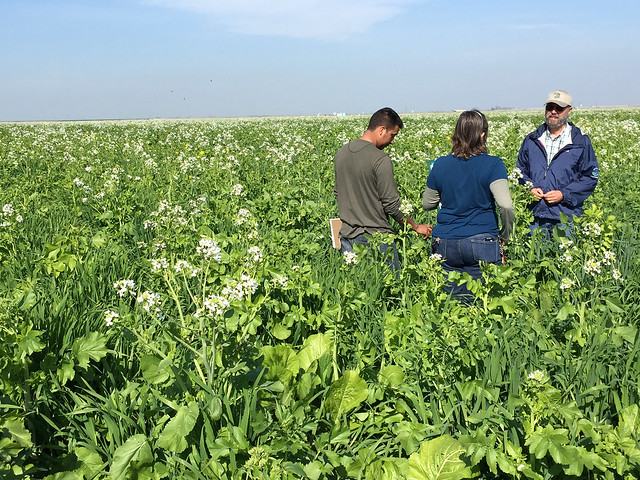



Agriculture is an essential part of the climate change solution
On the 49th annual celebration of Earth Day, NFU highlighted the existential threat that climate change poses to agriculture as well as the critical role of farmers and ranchers in mitigation and adaptation efforts.“Climate change is the single greatest challenge facing family farmers, rural communities, and global food security,” said NFU President Roger Johnson. “We should all be striving, every day, to be better conservationists, but Earth Day is an important reminder that this is the only planet we have, and we must work together to preserve it.”
Though warmer average temperatures, greater weather extremes, and rising sea levels affect every sector in one capacity or another, the consequences for agriculture are direct and immediate. “Family farmers and ranchers rely on reliable weather patterns for nearly every part of their livelihoods, from planting to harvest,” noted Johnson. "In the best of times, there’s always some uncertainty in what the temperature or precipitation might look like on any given day. But climate change has thrown these natural systems out of whack, adding even greater unpredictability into an already risky profession.”
As a result, farmers are facing more serious pest pressures, heat stress on livestock, and greater crop loss to drought, wildfire, and flooding – all of which mean lower yields and lower incomes. As the climate continues to change, one can expect these difficulties will only intensify.
Despite these seemingly insurmountable obstacles, farmers across the country are stepping up to mitigate the worst effects of climate change. Many are doing so by implementing conservation practices that build soil health and increase soil carbon sequestration, thus offsetting the greenhouse gas emissions that have fuelled this crisis. According to the most recent Census of Agriculture, cover crops were planted on 50 percent more acres in 2017 than in 2012, indicating a greater trend towards climate awareness.

US Department of Agriculture (USDA) Natural Resources Conservation Service (NRCS) staff participate in a cover crop field day in Merced County, CA as part of its tour of the state to look at ways farmers can reduce greenhouse gas emissions and store carbon on their lands © USDA
The environmental benefits of such practices should not be underestimated; according to researchers at UC Berkeley, US soils have the potential to sequester nearly 300 million metric tonnes of carbon annually, which could offset more than four percent of the total national emissions.
Farmers not only have the ability to sequester carbon in agricultural soils, but they have the opportunity to decrease emissions from their operations. One way to achieve this is on-farm energy production from solar panels, wind turbines, or methane digesters.
When considering the advantages of conservation practices, one might wonder why all farmers don’t implement them. It certainly isn’t due to a lack of interest, but the practices required to achieve those goals are often costly and labour-intensive, making it difficult for already cash-strapped producers to implement them.
Fortunately, the US Department of Agriculture (USDA) Natural Resources Conservation Service (NRCS) has a number of programmes that provide financial incentives and technical assistance to help farmers and ranchers move towards greater sustainability on their operations.
Jacob James Marty, a sixth-generation livestock producer from Wisconsin, was able to transition over 200 acres to no-till perennial production because of his participation in the Environmental Quality Incentives Program (EQIP) and the Conservation Stewardship Program (CSP), both of which are overseen by NRCS. “EQIP helped by cost-sharing our fencing, waterlines, water tanks, and seeding expenses,” Jacob acknowledged. “This made the decision to transition our working farm into a more conservation-minded farm much easier and practical.”
In addition to improving soil and water quality, Jacob has noticed other environmental benefits from these practices, most notably in the form of biodiversity. “We have seen a huge jump in insect populations on the farm, including bees and butterflies, and we have also had an increase in the amount of birds of prey.”
The practices have been good for Jacob’s bottom line as well. “We have significantly lowered our input costs by reducing the amount of field amendments, nutrients, and seeds that we need.” Not only is he spending less to produce the same products, but he’s making more money on them too. “Some of our products now also fetch a market premium, ranging from 20-300 percent over conventional, commodity prices.”
It is clear that incentive-based conservation programmes are critical in helping farmers like Jacob mitigate and adapt to climate change. Despite their demonstrable importance, these kinds of programmes are often threatened by a lack of political support and underfunding. As an example, early drafts of the 2018 Farm Bill would have eliminated CSP entirely and cut overall conservation funding substantially. This would have been bad for farmers and bad for the environment, as it would have added to the financial barriers that often prevent producers from improving sustainability on their operations.
One of the best ways to ensure that environmental policies truly help family farmers and ranchers address climate change is to include them in the development of these programmes. Farmers have a lot at stake in these discussions and excluding them will likely only generate resentment towards the resulting policy decisions. Additionally, as Jacob expressed, giving farmers a seat at the table is just a matter of pragmatism, because they are more aware of the realities of farming than anyone else is. “We have a good sense of what is practical or possible and can filter out unnecessary or impractical ideas or plans or policies.”
But regardless of policy, family farmers and ranchers will continue to look for ways to mitigate climate change.” We care about the environment,” said Jenni. “We all just have to keep working hard to do better for the planet.”
Jacob echoed the sentiment: ”We are in the middle of an environmental and climatic crisis. We are all responsible and accountable for being part of the solution.”









